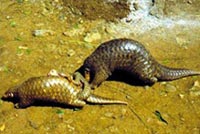Chinese Pangolin
(Manis pentadactyla)
Habitat: forests, bushes, or grass slopes in hills and
mountains.
Feeding habits: dig up ant caves with its sharp fore claws and lick ants and white ants with its thin and sticky tongue.
Food: ants, white ants, bees and other insects.
Size: with a body length of 40-50 cm and a tail length of 30 cm. Weight: 1500-3000 g.
Habits: Chinese pangolin is good at digging up caves. Usually, its fore limbs will dig and its hind limbs will push the soft soil away. It will soon sneak into the earth. Since its body is covered with deratin scales, it can dig caves very quickly as if it has method to penetrate the mountain; thus, it gets its name Chinese pangolin (means to penetrate the mountain). It usually acts alone. It rests in its cave during daytime and seeks for food during the night. Its senses of hearing and its visual ability are poor but it has very sharp sense of smell. Its teeth have degenerated and the sands and stones in its stomach will help it to digest its foods. Chinese pangolin can not only dig up caves, it can also swim and climb trees. Its mating time is in the spring and it will produce its young in the next winter or spring. It produces 1-3 young pangolins each time. When young Chinese pangolins become larger, they will ride on their mother's back to go out to seek for food. When they are endangered, Chinese pangolin would curl up and hide its head beneath its abdomen. This defending method is quite effective in dealing with other animals but it's useless to hunters. The shells of Chinese pangolin are a kind of traditional Chinese medicine. More, its meat is fresh and delicious; thus, they suffered a lot from wanton killing. Now, their number is greatly reduced.
Category: mammalia, pholidota, pangolin.
Distribution: all around
Yunnan. All provinces in South China.
Level of protection: class II key state protection animal of China.


|